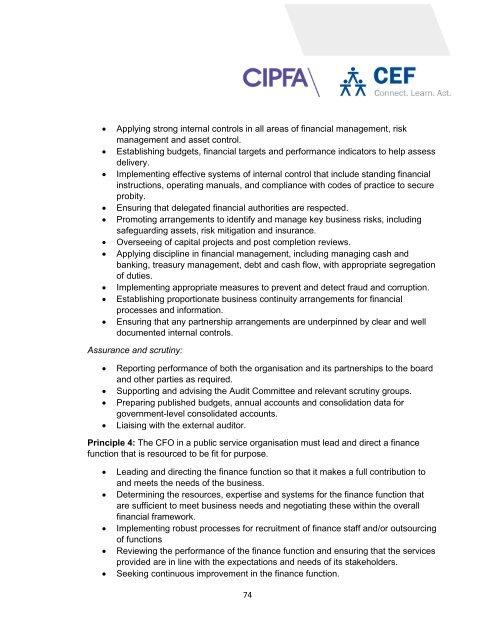You also want an ePaper? Increase the reach of your titles
YUMPU automatically turns print PDFs into web optimized ePapers that Google loves.
• Applying strong internal controls in all areas of financial management, risk<br />
management and asset control.<br />
• Establishing budgets, financial targets and performance indicators to help assess<br />
delivery.<br />
• Implementing effective systems of internal control that include standing financial<br />
instructions, operating manuals, and compliance with codes of practice to secure<br />
probity.<br />
• Ensuring that delegated financial authorities are respected.<br />
• Promoting arrangements to identify and manage key business risks, including<br />
safeguarding assets, risk mitigation and insurance.<br />
• Overseeing of capital projects and post completion reviews.<br />
• Applying discipline in financial management, including managing cash and<br />
banking, treasury management, debt and cash flow, with appropriate segregation<br />
of duties.<br />
• Implementing appropriate measures to prevent and detect fraud and corruption.<br />
• Establishing proportionate business continuity arrangements for financial<br />
processes and information.<br />
• Ensuring that any partnership arrangements are underpinned by clear and well<br />
documented internal controls.<br />
Assurance and scrutiny:<br />
• Reporting performance of both the organisation and its partnerships to the board<br />
and other parties as required.<br />
• Supporting and advising the Audit Committee and relevant scrutiny groups.<br />
• Preparing published budgets, annual accounts and consolidation data for<br />
government-level consolidated accounts.<br />
• Liaising with the external auditor.<br />
Principle 4: The CFO in a public service organisation must lead and direct a finance<br />
function that is resourced to be fit for purpose.<br />
• Leading and directing the finance function so that it makes a full contribution to<br />
and meets the needs of the business.<br />
• Determining the resources, expertise and systems for the finance function that<br />
are sufficient to meet business needs and negotiating these within the overall<br />
financial framework.<br />
• Implementing robust processes for recruitment of finance staff and/or outsourcing<br />
of functions<br />
• Reviewing the performance of the finance function and ensuring that the services<br />
provided are in line with the expectations and needs of its stakeholders.<br />
• Seeking continuous improvement in the finance function.<br />
74
















